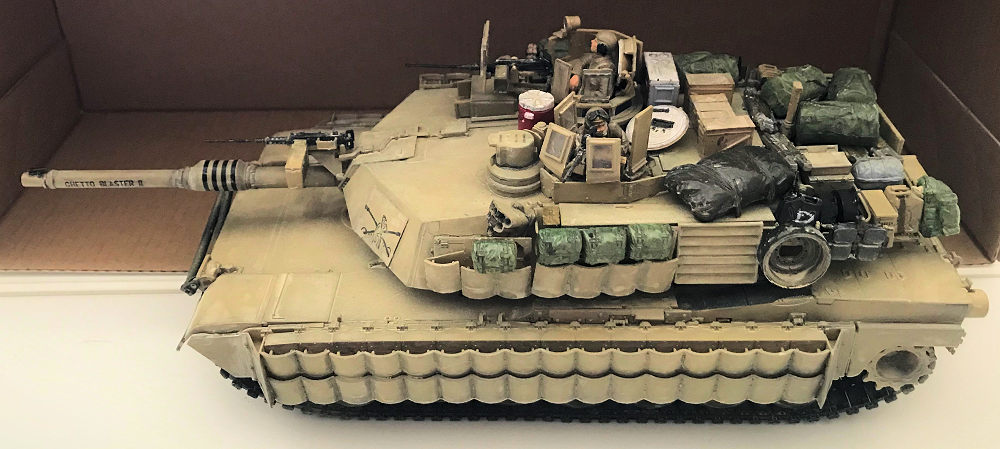
Academy 1/35 M1A2 Tusk II
| KIT #: | 13298 |
| PRICE: | $35.00 |
| DECALS: | Nine options |
| REVIEWER: | Donald Zhou |
| NOTES: | Advantages: Extremely detailed, single piece tracks, nine versions included. Disadvantages: Single piece tracks, instructions can be confusing. P.S. Tamiya Modern U.S. Equipment Set and Meng’s Individual Load Carrying Sets used |

| HISTORY |
The M1 series of tanks was developed in the 70’s as a replacement for the venerable M60. Previously, in a joint program with then West Germany, the U.S. produced the MBT-70 in the ‘60’s as a replacement. That never worked. The then new 155mm short barreled cannon, which can fire the Shillelagh missile was prone to break down and jamming. The rest of the vehicle didn’t fare better either and both nations eventually backed out. The Germans went on to produce their own very successful Leopard II MBT while the U.S. went on to eventually produce the M1.
The first prototype was produced in 1976. The winner was Chrysler. The Germans, who were adamant on selling the Leopard to the U.S. was deemed too expensive while the GM design was deemed too inferior. The tank was the XM1. After Chrysler was bought out by General Dynamics, the design was further improved. It had the same 105mm Royal Ordnance cannon found on the M60, which is upgradable to the 120mm Rhinemetal smoothbore found on the Leopard II. It also had massive improvement to the armor with the British Chobham ceramic armor plates that’s a whole generation ahead of the rolled homogeneous armor found in the M60. The biggest improvement however, was the fire control system. Previous tanks all used analogue sights with daylight vision systems. The M1 replaced them with digital fire control computers with laser range finders that was several jumps ahead along with a Forward Looking Inferred sensors that allowed the tank to fight at night or bad weather. Efficiency were greatly improved although older more experienced crews’ improvement was only incremental. However, the improvements among new raw crews was three or even four times better than older tanks, meaning they can be brought up to standard far quicker. The tank entered service in 1980 and quickly started to prove themselves. Over 3300 M1 were produced. The tanks can run up to 45MPH although there are reports of crews who disabled their governors on the tanks and went up to 55MPH and even beyond! The tank also features an AGT-1500 turbine engine. The engine is quiet, so quiet in fact, the tank gained a nickname of whispering death and can use any sort of fuel, everything from diesel, to straight gasoline and in a pinch, raw alcohol can be burned (although as might surmised, using raw alcohol will wreck the engine’s life). In service, the tank just uses diesel to save logistics nightmares. However, the big disadvantage is the turbine is a huge fuel hog and draws as much as a gallon of fuel for every mile and its infer-red signature is also quite high.
The next major upgrades is the M1A1 version. The biggest difference is the main armament. The Rhinemetal 120mm smoothbore replaced the British 105mm rifled cannon. This meant ammo capacity was dropped from 53 to 42. The other was the armor. Especially the HA (Heavy Armor) and HC (Heavy armor Common) variants, which contained a layer of depleted Uranium to further harden and upgrade the armor. Other improvements includes better bustle racks and a hole was opened just in front of the loader. This hole will prove critical for the next series of upgrade then in development. Over 6000 M1A1’s were produced, many of them are now or have been upgraded under the AIM or Abrams Improvement Management program.
The tank, now named Abrams after late Gen. Creighton Abrams, baptism of fire came in the Middle East. When Iraq and Sadadum Insane invaded Kuwait, U.S. and her allies quickly formed a line of defense to defend Saudi Arabia. Critical among the pieces were Abrams. In fact, over 1800 of the tanks were sent to the Gulf, many of them the latest HA variants to deal with the T-72’s. Before the battle, questions about the tank’s price and effectiveness abound but all of that was settled quickly when the tank proved itself in battle.
In fact, the Abrams
totally outclassed its opponents. It can hit its targets as far away as 2KM away
and its rangefinders and FLIR worked well in both daylight and night, especially
when smoke fire engulfed the region. In fact, one anecdote from the war shows
just how near invulnerable the tank was. During a drive, one Abram got stuck in
mud. The rest of the unit passed it by since they were under orders to keep
moving. While waiting for a tow, three Iraqi T-72’s attacked. The first one
fired a HEAT shell and did nothing to the tank. The M1 responded by firing an
armor piercing shell that nearly blew the turret off! The second o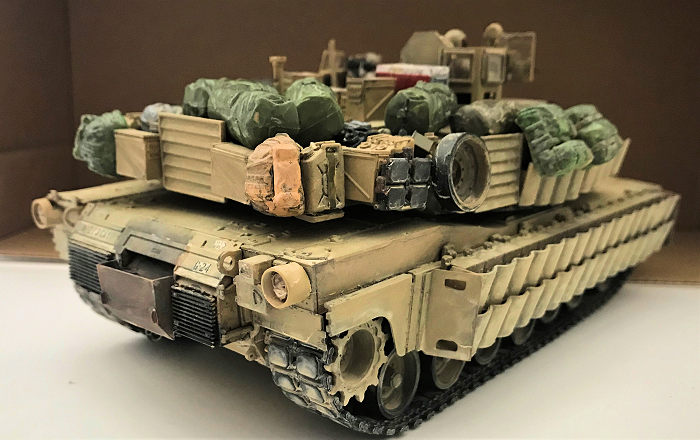 ne, not
heeding the lesson, also fired a HEAT shell that only made the tank angrier. A
second round turned this tank into a funeral pyre. The third tank, finally
heeding the warning, fired an armor piercing round that left a grove in the
Abrams frontal glacis plate but did not penetrate. Seeing further fighting was
redundant, it hid behind a sand berm, thinking it was safe. However, through its
FLIR unit, the Abram tracked the last Iraqi tank and saw the heat plume from its
exhaust and put the round where the turret was. The armor piercing round slammed
through the sand berm and still penetrated the tank on the other side.
ne, not
heeding the lesson, also fired a HEAT shell that only made the tank angrier. A
second round turned this tank into a funeral pyre. The third tank, finally
heeding the warning, fired an armor piercing round that left a grove in the
Abrams frontal glacis plate but did not penetrate. Seeing further fighting was
redundant, it hid behind a sand berm, thinking it was safe. However, through its
FLIR unit, the Abram tracked the last Iraqi tank and saw the heat plume from its
exhaust and put the round where the turret was. The armor piercing round slammed
through the sand berm and still penetrated the tank on the other side.
By this time, further Abrams had arrived but still no tow truck…Orders came from above to destroy the stricken tank in place. Since the rest of the Abrams crews did not have high explosives, they decided to use their main cannons for the job.
However, two rounds against the front armor proved to be useless, a tank came up against the side and fired one through the ammo storage bin and finally penetrated. All that did was to set off the blast off panel on top of the turret, which vent the explosive force upwards. After the fire died down, the tank proved to be as tough as ever! While discussing on what to do, the tow finally arrived and with three M88 recovery vehicles, the stricken M1 was finally dragged out of the mud!
There were some hard lessons too though. The least of which, like the M2 Bradley, it turned out, the biggest enemy wasn’t the enemy…it was friendly fire. Of the 9 Abrams destroyed in the war, 7 was from friendlies. At least two was from an errand AH-64 Apache strike with one total loss
After the war, further improvements were added. The biggest was the M1A2 version. The hole on top of the tank was replaced by a CIV or Commander Independent thermal Viewer. This allowed the tank to finally conduct “Search while hunt” at the same time. Electronics were further improved to allow one A2 to talk to another or any similarly equipped tank. Furthermore, to guard against the painful lesson of friendly fire, “cold” identification panels were added to the front of the turret, the side and rear. The A2 was also improved with the SEP or System Expansion Program and the SEP2, which added FBCB2 and other improvement to the armor etc.
By the time the second Gulf War rolled around, the Abrams that participated in this war only look like the same Abrams that participated in the first one. The insides though, were completely different and generations ahead. After the war, however, the Abrams faced its toughest test yet, fighting in urban terrain.
The fact of the matter is, tanks are not suited in urban terrain. They are too big, too unwieldy in a city and there are a lot of spots for insurgents to take pot shots at it. The press were quick to point out the Russian disaster that was Chechenia and Grozny. Insurgents quickly found out going toe to toe with an Abrams was tantamount to suicide. However, taking pot shot at it from the rear or firing an RPG from the rooftop at the tank’s roof is a far better option. Either that, or load up an IED and then blow up its soft underbelly!
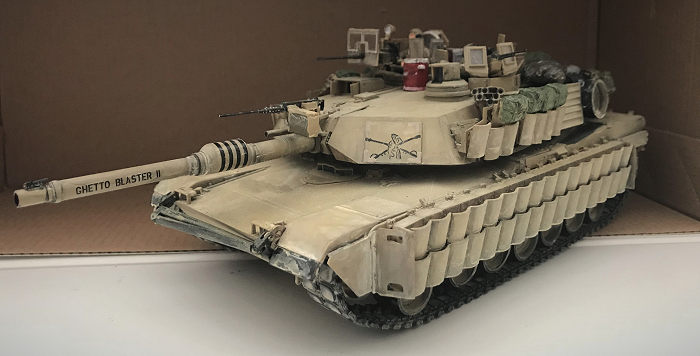 To combat this, the
Tank Urban Survival Kit upgrade was developed. This is a field upgradable kit
that radically improve the tank’s survival in an urban terrain. The first thing
added was something from WW II, an infantry to tank talkie phone on the back.
The next one was a “V” shaped armor piece that was added to the belly to not
only add armor strength against IED’s, but also to blunt and deflect the blast
away from the tank. The third is a series of armor glass panes were added to
both the commander and the loader’s weapon stations so they can operate their
weapons out of the tank without worrying about snipers. Finally, to guard
against the tank’s sides, a series of ERA armor panels were added to the tank’s
side skirts.
To combat this, the
Tank Urban Survival Kit upgrade was developed. This is a field upgradable kit
that radically improve the tank’s survival in an urban terrain. The first thing
added was something from WW II, an infantry to tank talkie phone on the back.
The next one was a “V” shaped armor piece that was added to the belly to not
only add armor strength against IED’s, but also to blunt and deflect the blast
away from the tank. The third is a series of armor glass panes were added to
both the commander and the loader’s weapon stations so they can operate their
weapons out of the tank without worrying about snipers. Finally, to guard
against the tank’s sides, a series of ERA armor panels were added to the tank’s
side skirts.
When introduced, the kit quickly proved popular and well suited in an urban terrain. However, further improvements were added from combat reports. These became the TUSK II kit. These includes: further slate armors were added to the rear engine grill. A second .50 cal machine gun was added to the top of the main cannon and a series of ceramic tile ERA armor pieces were added to the turret sides and onto the existing side skirt ERA armor.
With these improvements, the tank soon proved to be a hard nut to crack. There is a M1A3 version. However, due to budget cuts, that version is in limbo so the Army and Marines will have to do with the current version for the foreseeable future.
| THE KIT |
See my preview here.
So…Why did it take this long to build? I have my reasons…Once again, that 1/16 King Tiger is a big one…But also, getting distracted by various other projects is another big one. But finally I decided to bite the bullet and just finish a few projects on the “waiting to be completed” line before I start anything new…Which I broke as soon as this one was completed…….
But anyways, the previews still ring true. This kit is easy to build and just falls together. To complete it, I also bought Tamiya’s Modern U.S. military equipment set and Meng’s Individual load carrying set to fill the turret bustle racks as most operational Abrams are filled with all sorts of stuff on the racks and turret.
| CONSTRUCTION |
Before construction can begin, you need to remember there are three versions on offer, the SEP V2, TUSK I and TUSK II. I picked TUSK II. And mark down where you need to drill open holes for the version as there are quite a few. I missed few and have to eventually second guess.
Manual 1 deals mostly with the
lower hull and running gears. Again, the lower hull is divided into five parts
but they fit and most of them are pretty logical. The only mistakes are the
regular arms. If you look at the idler wheels and the shock absorber arms, they
have a little pin behind them. The regular arms don’t. This is incorrect. All
the arms should have them. However, since they are pretty much hidden, the point
is moot. All the wheels are designed to move if you are judicious with glue.
Just becareful with the hubs. They are clear. This is correct as the real thing
are also clear. The clear Plexiglas hubs contains the lubricant oil for the
wheels and the arms so the crews can see how much oil are left in there. Now,
for the
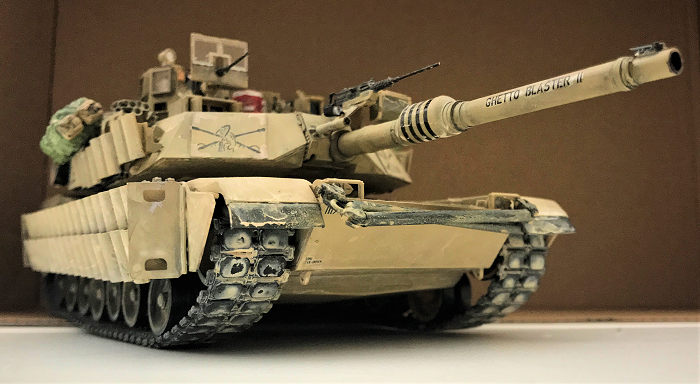 side skirt attachment points G26, G27, and G30, as it turns out, they
interfered with the attachment of the skirts. I ripped out G26 and G27 since G30
has a pin that needs to be attached to a hole in the skirt. You can’t really
tell since the skirts are held tight by the upper hull and you can’t see a thing
inside once they are attached,
side skirt attachment points G26, G27, and G30, as it turns out, they
interfered with the attachment of the skirts. I ripped out G26 and G27 since G30
has a pin that needs to be attached to a hole in the skirt. You can’t really
tell since the skirts are held tight by the upper hull and you can’t see a thing
inside once they are attached,
The last few steps in Manual 1 deals with the assembly of the rear panel. I left the clear rear lights off until final assembly. Careful with the rear grill mesh and the rear exhaust deflector E26. This part is almost always attached to the Abrams in an urban condition since the exhaust from the AGT-1500 turbine is extremely hot and can and will melt a hole in a wall or turn anyone standing directly behind it into a BBQ. I glued it in an angle so becareful!
The track assembly is novel. The vinyl tracks are not all that detailed…But then I don’t need to deal say, with Rye Field Model’s pesky six pieces per link assembly either…….You win some, you lose some……To connect the ends, two plastic pieces are used. I superglued the end pieces into the bottom plastic link, then used cement to glue them together for a tough assembly. The tracks are saved till the end.
Manual 2 begin with the assembly of a thin electrical wire that leads to the headlights. Careful as this part is extremely thin. The front tow bar is next. After 2003, nearly all Abrams are fitted with this massive heavy tow bar. I saved it till the end since I’ll paint it black. Although some are painted in Desert Tan so check your sources.
It’s time to deal with the side skirts. Two main version are offered. The regular thin ones for the SEP V2 and a version with holes in them for TUSK I and TUSK II. For TUSK II, remember to drill out the holes for the extra ceramic ERA tiles on the regular ERA tiles. I forgot the left side and have to match the ceramic tiles by eye. I saved the skirts until final assembly. The lower hull is mostly done at this point.
Time for the turret.
The turret assembly begin with the gun tube. Due to once again, modern slide mold technology, the gun tube is divided into three parts, the inner and outer one are attached together with the smoke discharger trapped in the middle, with the muzzle referencing system attached on top of the gun tube muzzle tip. Then the whole entire assembly is attached to the mantlet with the co-axle machine gun tube. This result in a round barrel with very few clean up. Just a few swipe of sandpaper to wipe out the mold line. The entire assembly is then attached to the lower turret before the top traps it together. But before that can happen. Time to open holes on the top of the turret. Read carefully which is which as TUSK II needs to open the most, while SEP II are completely different.
The rest all the way through Manual 3 deals with the turret exterior details. This start with the “doghouse” sighting unit, the .50 cal on top of the gun tube, the CITV sight, and the loader weapon station. A lot of small parts so do becareful. At least they all fit. Just notice this deals mainly with TUSK I and TUSK II. The V2 version starts at the mid-way point of Manual three and contains a really nice CROWS II remotely operated weapon system. Notice also with the TUSK I and TUSK II versions, you also will deal with a lot of clear parts due to the bullet proof screens around the commander and loader stations. Leave these off for now. The rest deal with the bustle racks, including a very nice bustle rack extension due to the fact the original one is now occupied by various air-conditioning units for all the “ve-tronics” in the SEP I and SEP II. After that is done, time to hit the paint shop!
| COLORS & MARKINGS |
For markings, I picked “Ghetto
Blaster”, a TUSK I vehicle in overall sand color from the choices. Yes, it’s a
TUSK I…But who’s to say later on, it didn’t get modified into a TUSK
II…Hehehehehehe :P! To start, the overall vehicle was heavily washed with
diluted Tamiya Flat Black and jet black artistic acrylics. The first coat of
Testors U.S. Army/Marine Desert Storm Tan was sprayed on followed by a heavy
wash of artistic cream acrylic to simulate sand. The sand found in Iraq is very
fine, akin to talcum powder or the powder stuff my wife put on her face every
morning. Just a tiny wind or even a kick from passing vehicles will pick them up
and spray them everywhere. This tends to get into every nook and cranny of men,
material and equipm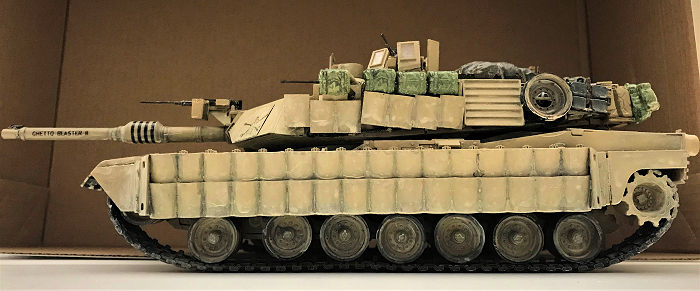 ent. The wash was also heavily applied to the track and the
running gears and wheels. Again, no rust on the tracks except maybe the spare
links. It’s not that the tracks do not rust, they do. But they are very
resistant to rusting due to their high magnesium count. Just how resistant? One
tanker put it basically, park the tank somewhere where there is a sprinkler,
turn the sprinkler on and leave it on for the next three days…And the tracks may
rust a bit, but only the connector rods due to the fact they are normal metal!
The tracks will only show rust after 5 days or so!!!!!!!! Besides, any rust that
do occur, once the vehicle starts and hits the road, the dust, especially sand
will sand blast the rust away anyways!
ent. The wash was also heavily applied to the track and the
running gears and wheels. Again, no rust on the tracks except maybe the spare
links. It’s not that the tracks do not rust, they do. But they are very
resistant to rusting due to their high magnesium count. Just how resistant? One
tanker put it basically, park the tank somewhere where there is a sprinkler,
turn the sprinkler on and leave it on for the next three days…And the tracks may
rust a bit, but only the connector rods due to the fact they are normal metal!
The tracks will only show rust after 5 days or so!!!!!!!! Besides, any rust that
do occur, once the vehicle starts and hits the road, the dust, especially sand
will sand blast the rust away anyways!
Once that is dry, Armored Sand are sprayed in spots to highlight the vehicle, before a second coat of cream and some Peach (yes Peach) acrylics were applied before another thinner coat of flat black for shadow. Then the tank was sprayed with two more coats of Desert Sand, thinner than before another coat of cream and black was added. For the exhaust port and the exhaust blast deflector, they are painted silver initially, but then was washed with Testor metallizer, Burnt Metal, then heavily washed with jet black, the jet black was washed over the top to denote exhaust stains there. Then burnt umber acrylic was washed over slightly to denote rust that happens quickly here due to the heat involved
The end result is a very dirty tank covered with sand. Pin washing with jet black was done especially to the various ceramic ERA tiles for highlights and shadows to really bring it some character. Time to add the various stowage to the tank!
| FINAL CONSTRUCTION |
Yes, as might expected, no operational Abrams will go out without some stowage, the back turret of some of them look like it’s carrying a ton worth of stuff in the bustle racks. One tanker on tv, when asked about this just shrugged and said basically the tank isn’t just a tank, it’s also basically home for the four tankers inside so they stuffed it with personal gear, rucksacks, sleeping bags etc. To this end, I got two sets of Tamiya’s Modern U.S. Military Equipment sets….Well, the problem is, it WAS modern when it was released back in 2003…..Now, not so, especially the ALICE packs. Those was replaced by the Individual Load Carrying System in 2004 so I got two of the Meng Individual Load Carrying pack also. The Tamiya one is still useful and highly recommended since if you can get hold of one from Japan, it cost only some $10 for two sprue of the same with ALICE packs, sleeping bags, a vinyl tarp, a tent in a bag, bed cots, jerry cans etc. It even contains two dogs and a few helmets. It also comes with a small sheet containing 18 MRE’s that you can cut out and fold into shape. I kept one as a “master” and bought some brown color paper, copied the “master” onto the color paper and folded them instead! Free MRE packs for my tank models for now on! HEHEHE! The Meng one is much more expensive. I finally found someone only willing to charge $12 for it and it contain only 1 sprue of various backpacks with vinyl straps…..Really not worth it for the regular price of $20 it usually go for despite the details.
For the various stowage, I folded
four of the MRE packs, colored the tent and tarp in olive drab. The next phase,
I chose four ten cots, four sleeping bags, four bed sheets. I painted these in
dark ghost grey for the bags and sheets, silver legs for the cots and olive
green tarp, the kit contains two spare wheels with some spare track links, I
painted them accordingly. I also painted the jerry cans, both the kits one and
ones from the accessory kit in their colors. Black for water cans, desert sand
for fuel. The water cans, two have “P” on them for “Potable” and two has “N” for
Nonpotable”. The next few are the 40mm and 20mm grenade cans. These are always
grabbed by Abrams crews since they seal off tight against the weather. T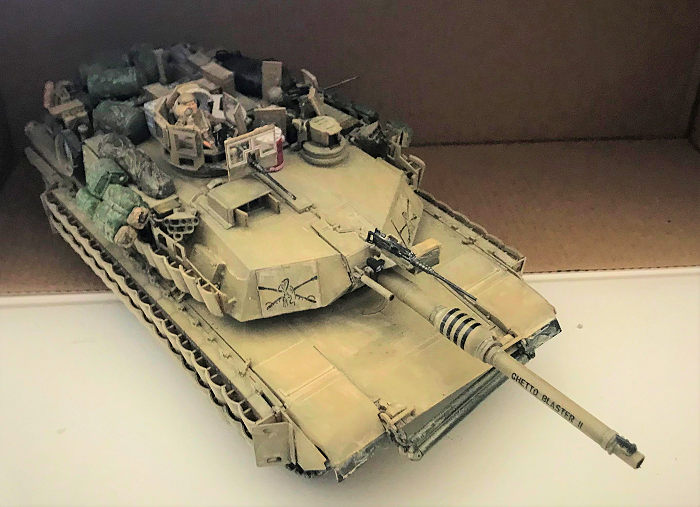 here are
also some fanny packs and duffle bags. I painted them in OD Green of my own mix
(Three olive drabs, one bright green and lightened with white). I took one of Meng’s Individual Carrying Set and modified the straps so they hung on the
racks. They are painted in tan, olive drab and my mix of OD green. After they
are all painted, they are weathered accordingly with cream for sand and flat
black. It is at this point that I received my Rye Field Model M1 ABV Shredder.
As I said in the preview, that kit contains a goodie sprue “O” that the Shredder
does not need and I promptly threw them in this kit! These include the
aforementioned two oil drip pans that are given to every Abrams crew, the water
coolers, which I painted red with white lid and then also weathered
appropriately.
here are
also some fanny packs and duffle bags. I painted them in OD Green of my own mix
(Three olive drabs, one bright green and lightened with white). I took one of Meng’s Individual Carrying Set and modified the straps so they hung on the
racks. They are painted in tan, olive drab and my mix of OD green. After they
are all painted, they are weathered accordingly with cream for sand and flat
black. It is at this point that I received my Rye Field Model M1 ABV Shredder.
As I said in the preview, that kit contains a goodie sprue “O” that the Shredder
does not need and I promptly threw them in this kit! These include the
aforementioned two oil drip pans that are given to every Abrams crew, the water
coolers, which I painted red with white lid and then also weathered
appropriately.
Time to stuff the tank! The two water coolers are cemented with the round one in front of the loader and commander, and the rectangular one behind them for easy access. Two of the 40mm and the four 20mm canisters are stuffed behind that. The four fanny packs are hung on the left side, two of the Individual Load Carrying packs are hung on the right, with the two other on the rear bustle, right beside the two other 40mm canisters. Center is occupied by the CID. The side of the racks are busy with spare wheels and spare tracks. The rest are jammed into the racks themselves with the oil drip pans, bed sheets, jerry cans, sleeping bags, MRE’s and cots. The four duffle bags with the tarp and tent are strewn over the rear of the turret. Overall, building the model was easy, most of the time was spent painting, weathering and doing the accessories!
With that done, it was time to deal with the tracks. After they are assembled, weathered appropriately along with the road wheels, they are put on the running gears, with the idler wheels removed for easy access. After they are on, the side skirts, now heavy with all the ERA modules are glued on, with the front and rear tipped with super glue so they will hold and not drop due to the weight.
The clear lights are now assembled, both the head and tail lights with the correct colors. Then the front fenders and the front tow bars was added. The front fenders are always black. This is because the polyurethane in the fenders just does not catch the modern polymer based paints and the paint quickly slough off the fenders, leaving them in the original black colors. Both are colored and weathered appropriately. Then the crew’s bullet proof panes was added, already painted and weathered to the correct stations before all the accessories were added! Model finally done!
| CONCLUSIONS |
This was a far more involving build than I
first imagined due to all the weathering and all the stuff I stuffed the tank
with. As a bonus, going through the Dragon M1A2 SEP kit that I brought all the
way from China so many moons ago, I discovered the two extra crew figures from
my ancient, now trashed Tamiya M1A2 kit! Ok fine, the crew may not be correct
(the body armor, helmet etc) and anyone who knows will probably point out. I
didn’t care, I used my paint scraper and removed their original paint, painted
them in the correct colors and put them in the tank as a final piece! Overall, I
had a blast! For $35, this tank is fun to build and you can go to town on the
weathering and accessories and look mean when done! Again, if you got money to
spend, get the Meng, Ryefield, or Dragon version of this tank since they are far
more detailed. But if you want to save a few bucks and get your best bang, then
this version more than fill the job! Otherwise, if you want an M1A2 TUSK or just
want another Abrams on the shelf, I highly recommend this kit.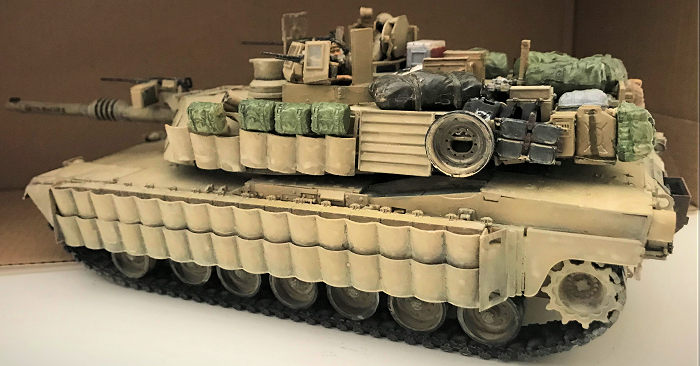 It’s majorly vice
free and anyone who has a few kits under their belt should be able to make a
wonderful armored vehicle. The only hitch for some are the vinyl tracks. They
are not nearly as detailed as say, Dragon’s magic tracks. Then again, the reason
I broke for this kit is because of the single piece vinyl. I’m tired of spending
three or four nights putting all the guide teeth onto those pesky tracks no
matter how detailed they might be in the end!!!!! This is why my Dragon M1A2 SEP
is still in its box! So the choice is up to you!
It’s majorly vice
free and anyone who has a few kits under their belt should be able to make a
wonderful armored vehicle. The only hitch for some are the vinyl tracks. They
are not nearly as detailed as say, Dragon’s magic tracks. Then again, the reason
I broke for this kit is because of the single piece vinyl. I’m tired of spending
three or four nights putting all the guide teeth onto those pesky tracks no
matter how detailed they might be in the end!!!!! This is why my Dragon M1A2 SEP
is still in its box! So the choice is up to you!
Overall, go get one! You will not be disappoint!
P.S. If you build the TUSK I or TUSK II version, you will still have the SEP V2 sprue left over. The clear sprue also has the correct clear SEP II clear hubs. So with that, you can convert any SEP I kit into a SEP II tank, like what I’m about to do to my Dragon M1A2 SEP I.
13 April 2018
Copyright ModelingMadness.com. All rights reserved
If you would like your product reviewed fairly and fairly quickly, please contact the editor or see other details in the Note to Contributors.
Back to the Main Page Back to the Review Index Page Back to the Previews Index Page